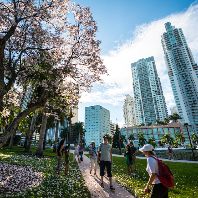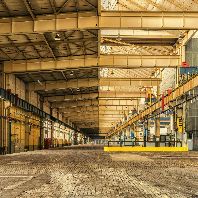The latest Active Capital research by Knight Frank forecasts that 2022 will be a record year for global cross-border real estate investment, with EMEA as a whole potentially capturing more than 60% of all cross-border activity. US investors are expected to be a major driver and provider of capital and could be behind almost half of the inbound demand. Within Europe, the UK, Germany, France, and the Netherlands are predicted to be the most popular destinations for cross-border capital.
All sectors across Europe are set to see increased cross-border investor interest. The office investment market is alive and 2022 is expected to be a bumper year for activity, with the highest demand from income-focused investment managers and institutions targeting the UK, Germany, France, and the Netherlands within Europe. We also expect interest in European logistics to continue with another record year for cross-border capital, while the residential sector is an increasing area of interest, right across the investor spectrum. ESG will become increasingly important for investors and occupiers over 2022.
Despite some headwinds to the economic recovery in the near term, with the benefits of vaccinations and other tools at hand, we are slowly moving to the stage where economies and the real estate sector are able to navigate well through this. While cost-push inflation remains a key concern for investors, it is expected to remain transitory. The European Central Bank (ECB) has indicated a wait-and-see approach in terms of monetary policy tightening. Although some national central banks, such as in the Czech Republic have raised interest rates, this is currently seen as an outlier in terms of monetary policy.
Austria
The Austrian real estate market has generally emerged as a winner from the pandemic, with robust price increases particularly for apartments. The Active Capital Research finds that the office sector is predicted to attract around one-third of the total cross-border capital coming into Austria in 2022, which will mainly stem from German investors. In the office leasing market, it is still unclear to many companies what long-term impact home working will have on their space requirements. We, however, expect a significant increase in demand for office space by the second quarter of 2022 at the latest once the evaluation of demand has been completed. Demand pressure for space in the industrial and logistics sector is clearly noticeable. There is currently a shortage of modern or generally available logistics space in the Vienna area. At present, occupiers are having to make do with their existing space or attempt to secure the next possible available space through pre-letting. From 2022 onwards, strong supply of new space will boost letting performance. In the residential sector, we expect prices to continue to rise in the coming years, albeit at a somewhat slower pace. The primary reason for this is the continued stability of real estate financing. Household debt is still low by European standards and borrowers are mainly crisis-resistant households with above-average and stable incomes. More than 60% of mortgages have a fixed rate of interest which means that they are also well protected against rising interest rates. In addition, social housing, and the regulated rental market in particular play a ‘stabilising’ role, at least for older buildings in Vienna.
France
2022 will be marked by the French presidential election. Current polls point to Macron winning a second term which would keep France on a pro-European course and support future EU integration, but the pandemic could cause further disruption and give momentum to far-right candidates. Although total investment activity may not be as dynamic as before the pandemic, the number of international investors active in the French market remains stable, while sums invested by domestic players may decrease again after the sharp fall already witnessed in 2021. Therefore, according to the Active Capital research, French offices are expected to be in the global top five for cross-border investment and industrial is forecast to be in the global top 20 for cross-border flows. While our model forecasts a significant increase in cross-border volumes, this is dependent on supply coming to the market which could remain tight. Limited prime supply, the high cost of land, changing lifestyles and work patterns and the priority of ESG criteria will support the demand for assets that are suitable for change of use or that can be adapted to remain relevant. Residential assets will also remain among the most sought-after by French and foreign investors, albeit against a backdrop of scarce supply. The success of "traditional" housing will be coupled with a growing interest in senior care and student housing and the development potential of certain concepts that are still relatively new in France (Build To Rent, Co-living).
Germany
2021 marks the end of a 16-year Merkel era. The new coalition – nicknamed “traffic light” after the colours of the parties that will make it up – has been given the task of setting a new course in 2022 to achieve the climate goal, maintain social justice, while at the same time keeping the economy competitive. In any case, the real estate industry is playing an important role as the federal government has created the new Ministry for Construction and Housing. So far, the German real estate sectors have proven to be resilient to pandemic impacts. As the need for flexibility shapes workplaces, occupier demand for office space in top locations that meet employee wellness and sustainability requirements is rising. This is also a prerequisite for competing for the best talent and is best realised in new buildings/refurbished stock and has led to an increase in prime rents in Berlin, Frankfurt, Munich and Hamburg throughout the pandemic. For 2022 we will see a mainly stable level of prime and average rents, office rents, in particular, will come under upward pressure. In the logistics sector, we see a clear increase in rental prices and space requirements range from large warehouses to small high street space for urban logistics operators. Office investments continue to be resistant to the crisis, with German offices predicted to be in the global top five for cross-border investment flows, according to Knight Frank Active Capital research. The majority of that capital is expected to stem from US investors, while German residential and industrial are also expected to remain in favour for cross-border capital. In expectation of stable income, mixed-use assets are gaining in importance. Overall, ESG credentials will play an even greater role. These multidimensional developments are likely to result in a stronger differentiation of rental and purchase prices.
Ireland
Occupier demand in the Dublin office market posted a strong recovery in the second half of 2021 as restrictions eased and a gradual return to work commenced. With a large number of requirements circulating, we anticipate that this will continue into 2022 despite the uncertainty created by the new omicron variant and the transition to hybrid working. Rents stabilised in 2021 and are primed for growth in 2022 as occupier demand for buildings with the best specifications and sustainability credentials recovers against a tight supply pipeline with over half of next year’s space already pre-committed. Investors continue to have confidence in the fundamentals of the market which are underpinned by continued strong job creation in high value adding sectors such as Technology, Professional Services and Finance. Though opportunities will be scarce, liquidity will continue to chase best in class properties – those with the strongest covenants, the best specifications and the highest ESG criteria – which will result in yields tightening below the current benchmark of 4.00%. We expect to see a greater divergence between prime and secondary office yields in 2022 than has been witnessed historically as demand for secondary offices continues to fall as investors take account of the increased letting risks and obsolescence. Within EMEA, Ireland offices are predicted to be in the top 20 for global cross-border capital flows, according to the Active Capital research.
Netherlands
Growth in 2022 is expected to remain robust amid a very low unemployment rate and record-high job vacancies. The strong labour market supports the demand for office space. The vacancy is low for prime office buildings and some new developments coming to the market should help absorb demand. As offices are likely to become a space for social interaction and collaboration, more space will be allocated to meeting areas and currently companies are not looking to offload large amounts of office space. Amsterdam prime office rents have remained stable and are still low in an international context which helps attract international businesses in combination with its high-qualified and multi-lingual workforce. Strong interest from global investors in the Dutch market continues and yields for core office product are at record low levels. Dutch offices are predicted to be in the global top five for cross-border active capital flows in 2022, according to our Active Capital Research. The Dutch industrial sector is also highly sought after by international investors and is predicted to be the fourth most active destination for cross-border capital within EMEA in 2022, according to the Active Capital research.
Poland
The outlook for the office occupier market in Poland is relatively optimistic. The vaccination program and the slower spread of the virus over the summer months encouraged many companies to return to their offices. Relocation processes have also been resumed and therefore office take-up in 2022 may be close to levels seen in 2020. Limited take-up in 2021 translated into limited developer activity and consequently new supply into the occupier market in 2022 is expected to reach the lowest level in a decade which may, therefore, lead to a decrease in vacancy. The Polish property investment market stabilised in 2021 with investors applying rather conservative investment strategies. In 2022, the investment trends are unlikely to change, as the market players have become used to the thought that the pandemic will last longer than previously expected. According to Knight Frank Active Capital research, Polish offices are forecast to be in the global top 20 for cross-border capital flows, as investors will look deeper into core-plus and regional opportunities with a focus on prime assets. Logistics assets will be sought after in all locations and set-ups. Demand for convenience retail and retail parks will continue. We can also expect to see much activity in PRS forward purchases.
Romania
The Romanian office occupier market is in a strong position to cope with the ongoing uncertainties. New trends triggered by the pandemic are starting to show, as companies reconsider their workplace strategy and place employee wellbeing and experience at the top of their requirements when searching for new office space. In 2022, we believe hybrid working will continue for most companies. Multinational companies are expected to enter the market as Romania offers prime office space with green certifications and high-quality technical specifications at a lower cost. The highly qualified workforce, particularly in the IT sector is also expected to be a large draw for multinationals. Real estate investments in 2022 are expected to be similar to 2021 volumes and will be driven mainly by the logistics and industrial segment, which has proven more resilient to the current uncertain environment. Likewise, the residential sector will likely account for a bigger share of the overall volume given the increased interest from institutional investors in projects suitable for long-term leasing, coupled to developers generally being more willing to accept lower margins but with a faster exit. Other segments such as retail and hospitality are expected to report moderate investment volumes. Transactions in these segments will most likely be on a speculative basis and, pricing expected to be adjusted to reflect the additional risks that might further affect the cash flows of these properties.
Russia
The Russian real estate market in 2021 was marked by new pandemic restrictions, construction cost growth, and rising demand in key sectors, trends that are likely to continue in 2022. In the office sector, the vacancy rate will continue its downward trend as tenants will face a limited choice of high-quality supply in key business locations in Moscow, therefore likely leading to an increase in office rents. The bulk of office space demand will be generated by large-sized IT companies. Online retailers will remain the key demand drivers for Russian warehouse space, absorbing large amounts of space in both new and existing projects. Rents increased to a historical high in 2021 and we expect further growth as future supply will primarily consist of built-to-suit projects. New formats such as light-industrial, city logistics and multi-storey warehouses will lead to market segmentation. In 2022, the Russian industrial sector is expected to be targeted by UK Listed/REIT investors for cross-border investment, according to Active Capital research. In the retail sector – depending on the development of the pandemic – the recovery of shopping centre footfall to pre-crisis levels can be expected not earlier than the first half of 2022. New retail supply in Russia in 2022 will be located in community centres and transport interchange hubs, particularly in the Moscow region. In the Moscow prime residential sector, there's an expectation for a gradual rebalancing of supply and demand in 2022, as well as a slowdown in price growth, which in 2021 was at a record high. There are no serious risks for the launch of new projects, in fact, the pool of prime real estate developers is expected to be replenished.
Spain
The Spanish economy is starting to recover, and employment has bounced back to pre-pandemic levels. From a real estate perspective, offices have been one of the sectors most affected by the health crisis, but the occupier market is expected to see an increase in demand as workers return to the office. The need for flexibility means occupiers are looking for less desks but more meeting space. Improving occupier demand is also positive news for the investment market and within EMEA, Active Capital research predicts that Spain is in the top 10 for office cross-border capital flows in 2022. Investor interest in the logistics sector remains strong as Spain is catching up in terms of e-commerce and the demand for last-mile logistics and warehouses continues to increase. Within EMEA, Spain is forecast to be among the top five destinations for industrial cross-border investment in 2022, our Active Capital Research finds. Yields are likely to compress further-reaching figures close to 3%. In terms of retail, supermarkets are the most defensive subsector and attract investor interest as they offer long leases and have performed well throughout the pandemic. Spanish retail cross-border investment will be among the top ten within EMEA in 2022. Looking at the alternative sectors, 2022 is expected to be a good year for the hotel investment market as the Spanish tourism industry recovers and hotel occupancy levels rise. According to our Active Capital research, within EMEA, Spain will only come second in 2022 for hotel cross-border capital flows, driven by US investors. Private Rented Sector (PRS) will continue its upward trend in 2022. New PRS developments have more facilities that attract young people who find it is easier to afford rented accommodation.
United Kingdom
December’s Economic Co-operation and Development (OECD) forecast predicts the UK to have the strongest growth of all G7 countries in both 2021 and 2022, with +6.9% and +4.7% growth in each year, respectively. The UK economy’s relative resilience has also been reflected in the commercial real estate sector, where we expect investment for 2021 to ultimately exceed 2019’s £54bn. Office occupier demand will continue to be directed towards the best-in-class buildings where rental levels achieved have been better than the market average. The likelihood of the market being overwhelmed with too many vacant buildings is also reduced by a constrained development pipeline. This will fall short of typical levels of take-up for new and refurbished office space. Demand for logistics space continues, while supply-side constraints limit delivery of new stock boosting rental growth. Logistics occupiers are having to agree to longer lease lengths in order to secure space and rent-free incentives have decreased due to competition. Looking to 2022, according to Active Capital forecasts, the UK is expected to enjoy record inbound investment next year. A combination of US private equity and investment management interest is forecast to support the UK office sector being the top global destination for capital in 2022. Meanwhile, the UK takes silver as second place for logistics investment and bronze as a global destination for the residential and retail sectors. Demand is expected to be broad-based, with investor interest from right across the risk spectrum albeit seeing North America as a significant deployer of capital. Sustainability will be a key focus for investors in 2022.















